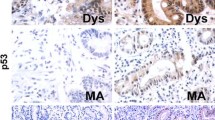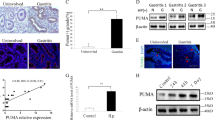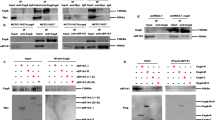Abstract
Helicobacter pylori infection is recognized as the major cause of gastritis and gastric cancer; however, its role in the development of gastroesophageal reflux disease and Barrett’s adenocarcinoma is unclear. The expression of NF-кB, AP-1, and COX-2 may be important in inflammation and tumorigenesis in the esophagus. The aim of this study was to examine the effect of live H pylori or H pylori extract (HPE) on these factors in the esophageal epithelial cell lines SKGT-4 and OE33. NF-кB and AP-1 activity were assessed by gel shift assay and COX-2 by Western blotting. Coculture of SKGT-4 and OE33 with live H pylori and HPE induced NF-кB and AP-1 DNA-binding activity, and also decreased IкB-α levels. Treatment with the specific MEK1/2 MAPK inhibitor PD98059, but not the p38 MAPK inhibitor SB203580, inhibited NF-кB and AP-1 activity. The antioxidant vitamin C inhibited H pylori-induced NF-кB activation, but increased AP-1 expression. Moreover, HPE induced COX-2 expression and IL-8 production, and PD98059 inhibited COX-2 expression, ERK1/2 phosphorylation, and IL-8 production. These data demonstrate that both live H pylori and HPE induce NF-к B and AP-1 expression in esophageal epithelial cells. The induction of such transcription factors may play a role in the specific immune response within Barrett’s mucosa and may indirectly cause inflammation of the gastric cardia and the distal esophagus.
Similar content being viewed by others
References
Parsonnet J. Helicobacter pylori: The size of the problem. Gut 1998;43(Suppl 1):S6.
Schistosomes, liver flukes and Helicobacter pylori. IARC Working Group on the Evaluation of Carcinogenic Risks to Humans. Lyon, 7–14 June 1994. IARC Monogr Eval Carcinog Risks Hum 1994;61:1-241.
Hosking SW, Ling TK, Chung SC, et al. Duodenal ulcer healing by eradication of Helicobacter pylori without antiacid treatment. Randomised controlled trial. Lancet 1994; 343:508–510.
Torrado J, Ruiz B, Garay J, et al. Blood-group phenotypes, sulfomucins, and Helicobacter pylori in Barrett’s esophagus. Am J Surg Pathol 1997;21:1023–1029.
Wright TA, Myskow M, Kingsnorth AN. Helicobacter pylori colonization of Barrett’s esophagus and its progression to cancer. Dis Esophagus 1997;10:196–200.
Goldblum JR, Vicari JJ, Falk GW, et al. Inflammation and intestinal metaplasia of the gastric cardia: The role of gastroesophageal reflux and H pylori infection. Gastroenterology 1998;114:633–639.
Voutilainen M, Farkkila M, Mecklin JP, Juhola M, Sipponen P. Chronic inflammation at the gastroesophageal junction (carditis) seems to be a specific finding related to Helicobacter pylori infection and gastroesophageal reflux disease. The Central Finland Endoscopy Study Group. Am J Gastroenterol 1999;94:3175–3180.
Graham DY. Helicobacter pylori infection in the pathogenesis of duodenal ulcer and gastric cancer: A model. Gastroenterology 1997;113:1983–1991.
El-Omar EM, Oien K, El-Nujumi A, et al. Helicobacter pylori infection and chronic gastric acid hyposecretion. Gastroenterology 1997;113:15–24.
Manes G, Mosca S, Laccetti M, Lioniello M, Balzano A. Helicobacter pylori infection, pattern of gastritis, and symptoms in erosive and nonerosive gastroesophageal reflux disease. Scand J Gastroenterol 1999;34:658–662.
Labenz J, Malfertheiner P. Helicobacter pylori in gastrooesophageal reflux disease: Causal agent, independent or protective factor? Gut 1997;41:277–280.
Vicari JJ, Peek RM, Falk GW, et al. The seroprevalence of cagA-positive Helicobacter pylori strains in the spectrum of gastroesophageal reflux disease. Gastroenterology 1998; 115:50–57.
Chow WH, Blaser MJ, Blot WJ, et al. An inverse relation between cagAC strains of Helicobacter pylori infection and risk of esophageal and gastric cardia adenocarcinoma. Cancer Res 1998;58:588–590.
Kopp EB, Ghosh S. NF-kB and Rel proteins in innate immunity. Adv Immunol 1995;58:1–27.
Baeuerle PA, Henkel T. Function and activation of NF-kB in the immune system. Annu Rev Immunol 1994;12:141–179.
Abdel-Latif MM, O’Riordan J, Windle HJ, et al. NF-kappaB activation in esophageal adenocarcinoma: Relationship to Barrett’s metaplasia, survival, and response to neoadjuvant chemoradiotherapy. Ann Surg 2004;239:491–500.
Jones AD, Bacon KD, Jobe BA, Sheppard BC, Deveney CW, Rutten MJ. Helicobacter pylori induces apoptosis in Barrett’s-derived esophageal adenocarcinoma cells. J Gastrointest Surg 2003;7:68–76.
Bradford MM. A rapid and sensitive method for the quantitation of microgram quantities of protein utilizing the principle of protein-dye binding. Anal Biochem 1979;72:248–254.
Laemmli UK. Cleavage of structural proteins during the assembly of the head of bacteriophage T4. Nature 1970;297:680–685.
Osborn L, Kunkel S, Nabel GJ. Tumor necrosis factor alpha and interleukin-1 stimulate the human immunodeficiency virus enhancer by activation of the nuclear factor kappa B. Pro Natl Acad Sci USA 1989;86:2336–2340.
Whitmarsh AJ, Davis RJ. Transcription factor AP-1 regulation by mitogen-activated protein kinase signal transduction pathways. J Mol Med 1996;74:589–607.
Cave DR, Vargas M. Effect of a Campylobacter pylori protein on acid secretion by parietal cells. Lancet 1989;ii:187–189.
Konturek SJ, Konturek PJ, Brzozowski T, Stachnura J, Zombala M. Gastric mucosal damage and adaptive protection by ammonia and ammonium ions in rats. Digestion 1996;57:433–445.
Kim JS, Kim JM, Jung HC, Song IS. Expression of cyclooygenase-2 in human neutophils activated by Helicobacter pylori water-soluble proteins: Possible involvement of NFkappaB and MAP kinase signalling pathway. Dig Dis Sci 2001;46:2277–2284.
Matsumoto K, Hashimoto S, Gon Y, Nakayama T, Horie T. Proinflammatory cytokine-induced and chemical mediatorinduced IL-8 expression in human bronchial epithelial cells through p38 mitogen-activated protein kinase-dependent pathway. J Allergy Clin Immunol 1998;101:825–831.
Laine L, Cominelli F, Sloane R, Casini-Raggi V, Marin- Sorensen M. Interaction of NSAIDs and Helicobacter pylori on gastrointestinal injury and prostaglandin production: A controlled double-blind trial. Aliment Pharmacol Ther 1995;9:127–135.
Wilson KT, Ramanujam KS, Mobley HLT, Musselman RF, James SP, Meltzer SJ. Helicobacter pylori stimulates inducible nitric oxide synthase expression and activity in a murine macrophage cell line. Gastroenterology 1996;111:1524–1533.
Noach LA, Bosma NB, Jansen J, Hoek FJ, van Deventer SJ, Tytgat GN. Mucosal tumor necrosis factor-alpha, interleukin-1 beta, and interleukin-8 production in patients with Helicobacter pylori infection. Scand J Gastroenterol 1994; 29:425–429.
Genta RM, Huberman RM, Graham DY. The gastric cardia in Helicobacter pylori infection. Hum Pathol 1994;25:915–919.
Preikseitis HG, Tremblay L, Diamant NE. Nitric oxide mediates inhibitory nerve effects in human esophagus and lower esophageal sphincter. Dig Dis Sci 1994;39:770–775.
Mukhopadhyyay A, Rattan S, Goyal RK. Effect of prostaglandin E2 on esophageal motility in man. J Appl Physiol 1975;39:479–481.
Keates S, Hitti YS, Upton M, Kelly CP. Helicobacter pylori infection activates NF-кB in gastric epithelial cells. Gastroenterology 1998;113:1099–1109.
Wetscher GJ, Hinder PR, Bagchi D, et al. Free radical scavengers prevent reflux esophagitis in rats. Dig Dis Sci 1995; 40:1292–1296.
Oh TY, Lee JS, Ahn BO, et al. Oxidative stress is more important than acid in the pathogenesis of reflux oesophagitis in rats. Gut 2001;49:364–371.
Author information
Authors and Affiliations
Corresponding author
Rights and permissions
About this article
Cite this article
Abdel-Latif, M.M., Windle, H., Terres, A. et al. Helicobacter pylori extract induces nuclear factorkappa b, activator protein-1, and cyclooxygenase-2 in esophageal epithelial cells. Journal of Gastrointestinal Surgery 10, 551–562 (2006). https://doi.org/10.1016/j.gassur.2005.09.003
Issue Date:
DOI: https://doi.org/10.1016/j.gassur.2005.09.003




